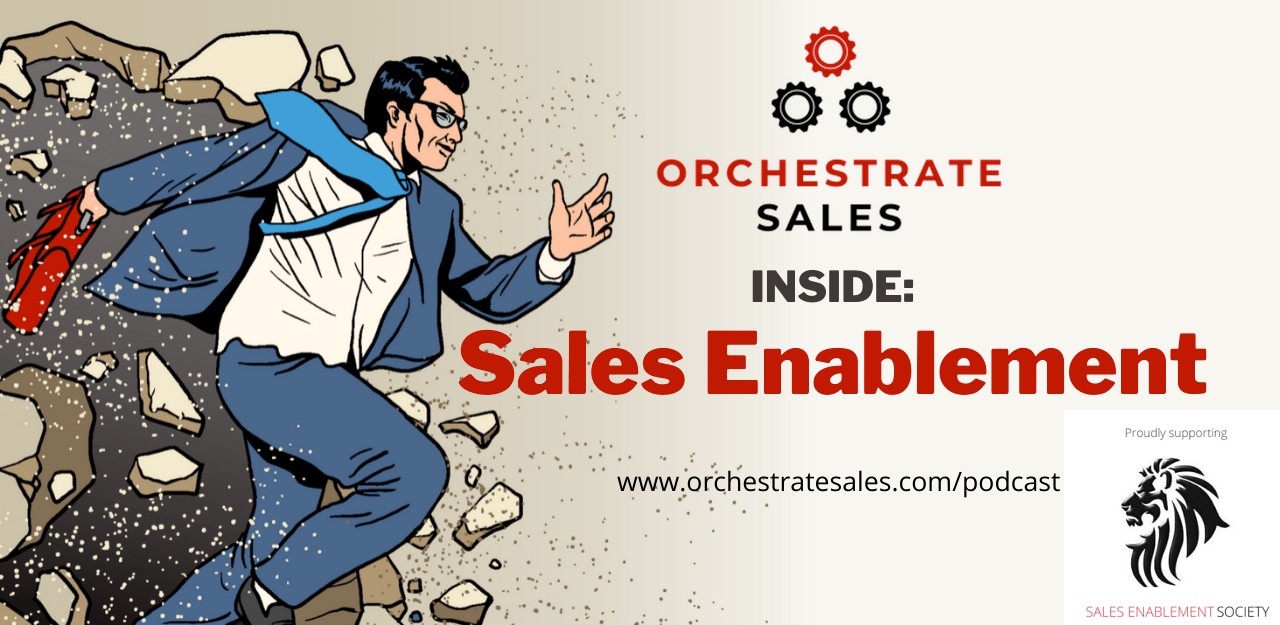Ep18 Manage Up & Across: Deploying SE Technology with Amy Benoit
Welcome to the Inside Sales Enablement Podcast, Episode 18
In this episode, a listener (Amy) calls into the show to discuss managing disparate workgroups globally. The great thing about Amy is she has a marketing operations background -- and considers herself a sales enablement practitioner. Because she has a marketing operations background, she has a broad, yet practical view of what sales enablement deployments look like.
Her biggest challenge? Managing up.
As someone who helps sales sell, the experiences Amy has experience in
• “Connecting dots” across a variety of stakeholders including business units, marketing ops, sales ops, sales enablement, and sales leadership
• The idea of “governance” and what it means to ensure the various stakeholders have a say and protect the brand
• The feedback loops using analytics and voice of sales data
• Participation in the governance conversation
• The idea of “taxonomy” and what it can mean to a variety of different stakeholders
• The regional/global view of enrolling others in country
Join us at https://www.OrchestrateSales.com/podcast/ to collaborate with peers, join Insider Nation, participate in the conversation and be part of the continued elevation of the profession.
EPISODE TRANSCRIPT:
Nick Merinkers 00:02
Welcome to the inside sales enablement podcast. Where has the profession been? Where is it now? And where is it heading? What does it mean to you, your company, other functions? The market? Find out here. Join the founding father of the sales enablement profession Scott Santucci and trailblazer Brian Lambert as they take you behind the scenes of the birth of an industry, the inside sales enablement podcast starts now.
Scott Santucci 00:33
I'm Scott Santucci.
Brian Lambert 00:35
And I'm Brian Lambert is a sales enablement insider. Our podcast is for sales enablement, leaders looking to elevate their function, expand their sphere of influence, and increase the span of control within their companies.
Scott Santucci 00:47
Together, Brian and I've worked on over 100 different kinds of sales enablement, initiatives as analysts, consultants or practitioners. We've learned the hard way of what works and maybe what's more importantly, what doesn't.
Brian Lambert 00:59
We like to think our podcast is different, and our listeners are telling us that it's different. And we use a conversational format to help share the experiences and only people who've been there and done that can provide, as we've been pushing the envelope in the profession for over a decade. And today, everybody, I'm pretty excited about this episode because we have a very special guest. We have Amy from a large matrix organization. She's actually in marketing operations. And she's joining us today in response to our podcasts that we've been having on stakeholder management. So hi, Amy, how are you?
Amy Benoit 01:35
I'm well, how are you?
Brian Lambert 01:37
Great. Thanks so much for joining us. I know we had one quick conversation and we're throwing you on here. But we've done two episodes, we did an episode 13 we did a chicken Hawk episode and that, that got quite a lot of buzz on LinkedIn. And then as a follow up to that four episodes later in Episode 17. Scott and I walked through a story that I had around Managing stakeholders and a large fortune 50 company. And you reached out to us based on those two podcasts. And Scott, you know what? I'm bringing her on here today. You haven't even talked to her. And we're gonna put you on the spot.
Scott Santucci 02:14
I love it. That's great. So, you and Amy go way back then, huh?
Brian Lambert 02:20
That's right. But But she's part of the insider nation. And we should consider family but she's coming after you. And I say Here we go. So
Amy Benoit 02:31
nicely.
Brian Lambert 02:32
That's right here from Pennsylvania here. So so, um, I really appreciate Amy, your background and how you've been involved in sales enablement. And one of the things that that was cool to hear from you is how you're passionate about helping salespeople be successful. But I'd love to hear from you. Why do you want to join us on the on the podcast today?
Amy Benoit 02:56
Well, you know, I listened to that fantastic podcast episode about humble chicken Hawk, and I thought, oh my goodness, this is part of my world, I am tasked with just executing something that is very large and trying to figure out how to collaborate and get that buy in from all of these different stakeholder groups because as chicken Hawk found out, you know, everybody wanted something. And so, I, you know, my heart went pitter patter a little bit because I could totally relate. And then I was so excited that you however many out it was like three or four episodes later, you kind of, you know, you broke it down a little bit more and went into that whole stakeholder management piece because it resonated with me, it's critically, you know, important in our organization. And I like could really appreciate how the level of effort that went into putting together the plan. And then of course, you have to operate the plan. And some of the trailing points there, as you were leading the discussion was, you know, how do you really more effectively manage up? And I think for me, I was like, Huh, that's a great question. Because while we and our you know, in our organization are charged with the same, you know, managing down, across and up, I would love to hear your expertise on how do you more effectively manage up.
Scott Santucci 04:35
Excellent. So, what we're going to do now is we're going to move into a section of our podcasts. So, if you followed along, this is very much like the conversation, Brian, that we had with Beth, but air quotes, but we're going to do some speed date consulting. And this is just a conversation between Amy and myself. Brian's going to pick it up and say what does this mean for Less than or so, Amy, when you talk when we talk about what expertise we have, I need a little bit of information about what it is that you're trying to manage in the first place. Right. So, what if you could give me a scope of the business problem that and what your remit is? I'd really love to get some context on that.
Amy Benoit 05:20
Sure. So, I am tasked with essentially leading the strategy for our sales enablement portal. And we are a unique organization and that that portal actually sits in our marketing office, you know, our Mar tech stack. So, I'm engaging oh my goodness, every day with sales. You know, that's, that's Sales Users, sales leaders, marketing stakeholders, Product Management, legal sales, support and so on. And one of the things that I find challenging is as well I get a lot of people who kind of understand what we have to say in See the value. I also want to, like get to a point where I have more aligned conversations with some of the leadership team. So how can I make sure that we're embedding some of those valuable metrics and learning points that tie back to our corporate imperative with our leadership team, so that they then you know, it's never a good point to say, you know, that they're gonna put a management down style, right? We always want that groundswell of users and people adopting our portal. But I really want to pick your brain and understand how it is best to engage with senior leadership. What are the things that resonate with them and how can they then cascade that information back down to their teams, so there's a circular loop?
Scott Santucci 07:00
Yeah. So, let's start there. So, you said something that you're responsible for the sales enablement portal that's part of the MAR tech stack. So, I assume you've made an investment already.
Amy Benoit 07:13
Absolutely. Yeah. So, we've had an investment. We've been operating our sales enablement portal for about five years now. And that's been funded on the marketing side.
Scott Santucci 07:25
So, let's go back to one of the things that's really vitally important. So, in terms of in terms of story arc, and I feel at I feel a bit handcuffs since I don't have a whiteboard. But if whiteboard, what I do is sort of imagine a story arc, right? And the story arc starts with why and then now, so why did the did this investment happen? And that's really where I want to start off with Because if I understand why, then I get get to now. And then we can start figuring out the different messaging. So, if you can give me what was the business driver that made the investment? And, you know, you don't need to tell us how much the investment was, but it was it was it significant? Was it little? How many people were involved? How, how much went into that?
Amy Benoit 08:23
Sure. That's a great question. So, it was a significant investment. And, but I will say, you know, we started more with a proof of concept, and then grew adoption from there. But really, you know, one of our driving factors as to why was, you know, twofold. We really wanted to have a place that was the source of truth for content. And we also really wanted to streamline and kind of shave off that time it takes for sellers to get those resources, kind of you know, get their business. airings and facilitate those conversations with their prospects and clients. So, looking to, you know, reduce the amount of time in process that it would take, you know, for a seller to get that kind of competency and, and direct conversation and also provide a place that people thought of as the source of truth. I will say, you know, we have driven he continued to drive towards, you know, those goals and, and have had success for sure. I think sometimes, you know, where we're headed now is, you know, other technologies come into play. And we want to continue to kind of point out the value and point out the connectivity between our platforms, that how can we ensure, you know, leadership is really continuing to connect those dots? Yes. So, what I would also imagine to just what you my last context question, before we get into it, I would assume that, so the audience doesn't know what company you're in, I know what company are in. So that's a little unfair. But I would assume that the amount, you have lots of products, you have different sales teams. So, part of the benefit of using an outside provider to provide a technical platform is to help provide, you know, connecting across all of that information. Is that true? So, part of the difficulty or not the difficulty, part of the complexity is that you'll have each one of your sellers can configure different different products and services together, they can configure different conversations together based on the complexity of the accounts that they're selling, too. Is that is that accurate? That is accurate. I mean, we do have them very expansive product portfolio. And, you know, being a part of a matrix organization and operating in 17 countries, we do follow some internal structure where we have sales teams obviously aligned by channel but also, you know, teams aligned to industries and capabilities. So, we have a lot of information to manage, and being able to have that central location that not only allows me access but allows us to see what's being used and allows those who are producing the content to ensure that the most current on brand legal compliant piece of content is accessible, that's how you know of high importance to us. So there, you know, by nature of where I fit, you know, interacting with all of these things. Different groups, and we're kind of like sitting at the hub of it, you know, there's a lot of importance placed on being able to not only streamline the processes, but you know, facilitate best practices as it relates to content. And, you know, provide a through our platform, that level of governance and kind of, you know, taxonomy in the sense of how that content is served up and aligned based on different regions and different industries and capabilities.
Scott Santucci 12:36
Yeah. So let me give a really simple framework here that will help drive our, our conversation. We have a challenge of communicating up, across and below. You're asking us about up right so we're going to just concentrate on. So, if you're following along in the bouncing ball. One of the challenges in order to do that, however, is you can't Only skewed adjust up. So, what I'm going to talk about here is apparently I am very much focused on on children's children's stories. But think about this as the Goldilocks condition, right? We have all the lights goes in the dad's bed is too big. kid's head is too small. You know, the middle one is just right. So how do we find the Goldilocks condition about managing information? And how we arrive at that is sometimes we start out too abstract. Because what we want to do is we want to find the simple, but the most basic, simplest design point. And then we can get to detail because we have so many different people who want their thing right now at this moment, and how do you balance between the two? So, what I've learned is that when talking with executives, I start with the abstract, the or what might seem too abstract. Which is too simple. So, one way to think about this is a platform like you've invested simple or too abstract, is I like to think about this as sort of like cable, a cable set box for sales. This is getting dated, right, I'm gonna have to come up with a different analogy as everybody moves to most digital, the cable set box for sales, where we can provide lots of programming, and that each individual seller can tune into the network programming that's available for them. And then you can work with all the other content suppliers who have their own shows, or have their own channels, different product, marketers might have their own channels. And of course, like any network, there's going to be FCC rules associated with things for standards in the like, you have compliance, that chapter factor too, because what, what what decencies in so is that in terms of that model, does that work as a starting point?
Amy Benoit 14:56
Yes, that works. And I'd like where you're headed. With that, because you know that that's kind of, you know, what we have driven towards. So, I'm, I'm curious to hear your thoughts on how that can be more effective.
Scott Santucci 15:14
Right. So the reason that I share that is typically what happens and this is a story in general, I'm not saying this is the story that's happening inside your company, but story in general is there's a lot of momentum to get something like this going, and and each person who funds this because I doubt, maybe the funding got picked up by marketing, but I doubt very seriously marketing was going to advance forward unless they had support from sales, different sales, sales leaders, and I'm sure there was other people that had to chime in on it as well. Maybe it had to get bought in so there's a lot of cooks in that kitchen, and everybody's got very specific expectations. And so, you go through that process, and that helps get it started. And then you know, as it goes, On, what happens is people give feedback on maybe the design of the tool. So, if we use our cable set box analogy, we're going to get feedback on, hey, you're scrolling bar of how you communicate what what programming is available. Why don't you modernize it? Or this particular show sucks? fix that. Or I want reporting, I want analytics on how many people are using this or what their clicks are. And can you tell us about you start imagining if you're a network business, like a cable provider, start imagining all of the different information that you can have. And soon you are just spent time talking about all these deliverables and we're offside of managing the expectations. Why did we find this uh, this network in the first place? So, what I like to do is kind of go back and always make sure that for the key stakeholders and the way that I like to envision this is that you're Running a business within a business and the business that you're running, you're operating is this network, right? The cable set box, you are the cable provider for your company company x. And as that cable provider, you have a as a business within a business, you have investors. So, who are those investors? And what is it they want? So, I think we need to get back to what what is it that you're doing that can always add value to say the CMO. And maybe we can identify where the CMO is, are there issues about where we can bring branding in the trenches? Or is it an issue of where we can start communicating differentiation, or we can start seeing better connection points of all the sum total of all marketing, Product Marketing, for example, and the value there not just clicking into each individual click point. So, I'm going to I'm going to pause there. And then let's think through what are the ongoing value drivers that the CMO wants to provide to the rest of the company? And how does your business within a business help make him or her successful? Because I think if we start there and get really discipline and think about five things, then we can move on to a different stakeholder like a sales leader of a particular, I'm sure you're organizing verticals, or geographies, or things like that. So yeah, so let's just concentrate on the CMO since that's where the budgets happening.
Amy Benoit 18:35
Sure, so definitely, you know, on brand on brand content, compliance content, you know, so so ensuring that content is reviewed and updated within a specified cadence. Being able to support new Product initiatives, that's another important area. So that we have a way to bring in that information and communicate that out to our users. So, a little bit of a, you know, internal columns perspective. And really, you know, and I guess the other thing that I haven't mentioned, you know, were under a, some different technology transformations. But you know, our end goal is to eventually connect our sales enablement portal to our Salesforce instance and serve up that content to our seller so that they don't even have to look for it, you know, in essence, kind of shaving off more of that process time for them to be prepared. So, we we also, you know, carry that on the side of the marketing house. So, you know, that is very important to us from a measuring what works, what's getting used, what works. That these teams can go back and refine their budget. Yeah, and produce content that resonates.
Scott Santucci 20:08
So, let's, this is great just to start off with, right. So, you've mentioned a variety of different value drivers. We don't have the time to go into that. But here's how I'd like you to think about it. So, the CMO, you hit you have two ways to give updates to him or her, right? One way is, hey, I'm getting a lot of complaining about X, Y or Z and we can just start imagining all start rolling our eyes about all the complaints uhm product marketers think that oh my god, I got to do all this tagging. Why can't I get my beautiful material out directly to the...




